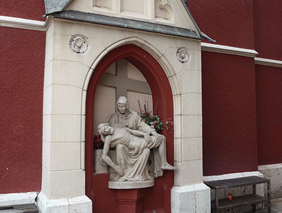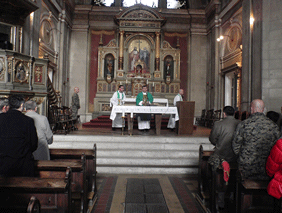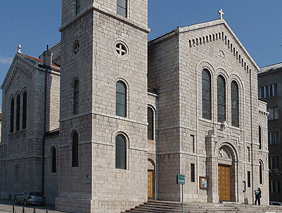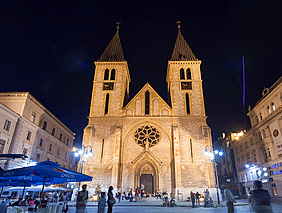European Jerusalem › Catholic Sacral Monuments › Franciscan Monastery and Church of St. Anthony of Padua

Franciscan Monastery and Church of St. Anthony of Padua

The Franciscan Monastery was built in 1894 according to the design of Karl Panek in Neo-Gothic style. The church was designed in floral Gothic style by Josip Vancas in 1912 and completed in 1914 when the tower bells were set.
Location: Old Town

The monastery has a valuable collection of paintings, sculptures, an organ, archive material, old manuscripts and books, beautiful stain-glass windows made by the painter Ivo Dulcic. The church was originally built in 1882, and after severe damage to this edition, a new church was built in 1914. This was the last sacral monument designed by the famous architect Josip Vancas. The present-day church dates back to the 1960’s when its renovation started and lasted for two decades. As a result, today this beautiful church holds valuable works of eminent Croatian painters. This is more than a Catholic sacral monument. It is a church of all Sarajevans, especially on Tuesdays and Fridays, when no matter the religious background, people like to gather and pray.
Franciscans, members of the Ordo Fratrum Minorum (Order of Friars Minor) established by Francis of Assisi, have been present in Bosnia and Herzegovina since 1291. They arrived here by the order of Pope Nicholas IV to repress the "Bogumil heresy”. In 1340 they established a Vicarage, and in 1517 established the Bosna Srebrena Province, named after their monastery in Srebrenica, in the eastern part of Bosnia. Nowadays, the seat of Bosna Srebrena is in Sarajevo. Franciscans have 14 monasteries with rich libraries and two residences, the Franciscan Theology, Franciscan Faculty in Sarajevo and the Franciscan Seminary in Visoko. Franciscans are loved and respected in Bosnia and Herzegovina. They have been present here for over seven centuries and from the establishment of Sarajevo. No wonder they are also referred to as "the guardians of Bosnia”.
Other related objects
Church of St. Cyril and Metho ...
This complex was designed by Josip Vancas in 1895. The seminary has two wings, designed for studying with a library, and a domed church in the middle.

|

Za sve informacije pozovite TIC svakim radnim
danom od 9h do 20h (zimska sezona od 9h do 17h) + 387 33 580 999
danom od 9h do 20h (zimska sezona od 9h do 17h) + 387 33 580 999
BOS

O Sarajevu
Saznajte praktične servisne informacije o Sarajevu
Događaji i novosti
Saznajte više o predstojećim i aktuelnim događajima i festivalima u našem gradu
Copyright © 1999-2014 - Tourism Association of Sarajevo Canton - All Rights Reserved design and development by DWS - January 2015

















